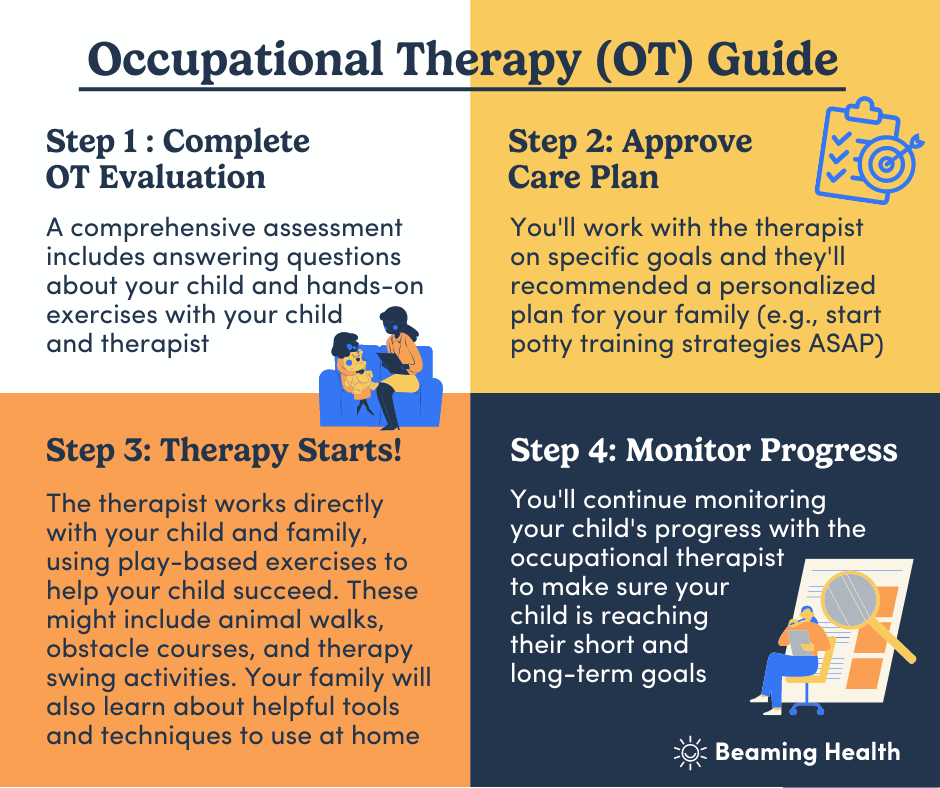Occupational therapy: Does my child need it?
Updated: October 17, 2023 · 7 Minute Read

Reviewed by:
Kim Arzillo, MS, OTR/L (with Opya, Inc.)
Highlights
- Occupational therapy helps kids with autism and other sensory processing differences develop life skills that allow them to engage and participate in meaningful activities such as play, self-care, and academics.
- Occupational therapy also helps children develop motor skills, improve sensory processing, understand and regulate their emotions, and draws on a child’s strengths to help them succeed.
- You can expect occupational therapy sessions to last 30-60 minutes, with one to three sessions per week.
- Occupational therapy is usually covered by health insurance, with government benefits, and in certain school settings. An OT session typically costs between $100 and $200 per session without health insurance.
Occupational therapy: Does my child need it?
Many children with sensory processing differences like autism and ADHD benefit from occupational therapy. If your child experiences any of the following, ask an occupational therapist for an occupational therapy evaluation.
- Delayed fine motor skills, including difficulty grasping objects, challenges with handwriting, and challenges with zipping or buttoning clothing
- Impulsivity, including challenges in understanding and regulating emotional states
- Challenges in visual processing and visual motor skills, such as visually tracking objects, copying/ tracing shapes and letters when writing, or locating items in a visual field, like finding a spoon in a drawer of different utensils
- Sensory processing differences, such as over or under-sensitivity to various sounds, textures, smells, tastes, body position, and internal states like hunger/thirst
- Delayed ability to perform self-help skills, such as feeding and dressing, by the typical age milestones
- Developmental delays evident by decreased ability to reach developmental milestones by expected dates
- Dysregulated body and/or emotions, including seeking or avoiding sensory input in some situations (e.g., this can look like frequent jumping or heightened anxiety in certain everyday situations)
- Decreased ability to focus on tasks and directives, including academics and daily living activities
What is occupational therapy?
Many people think “occupation” only refers to work, which can be confusing when a child is recommended for occupational therapy (OT). In occupational therapy, occupations refer to any everyday activity that we engage in which brings purpose and meaning to our lives. Occupations can be activities at home, school, or in the community. Occupations may include activities in any of these categories:
- Activities of daily living (e.g., bathing/showering, toileting, dressing, hygiene and grooming, feeding oneself, eating and swallowing, and moving from one place to another)
- Health management, rest and sleep
- Education or work
- Play, leisure and social engagement
Occupational therapy is an activity-based therapy that focuses on developing and maintaining skills related to living an independent life. Occupational therapists empower children to engage in “occupations” or day-to-day activities.
Some of the areas an occupational therapist may work on include:
- Gross motor skill development, such as sitting, jumping, and throwing/catching a ball
- Fine motor skill development, such as clapping, holding/grasping, releasing larger and smaller objects, pointing, and using utensils
- Sensory processing which includes tactile/touch, smell, taste, vision, auditory, head position, body position from movements of muscles and joints, and sensations from inside the body like feeling hungry or thirsty
- Self-care, such as grooming which includes washing hands, brushing teeth, combing hair, feeding oneself, eating/swallowing, bathing/showering, toileting, and dressing/undressing, which includes managing buttons, zippers, and shoelaces
- Writing and pre-writing, which includes drawing, typing, and texting
- Motor planning skills which allow us to learn and remember how to perform body movements needed for everyday tasks such as walking and brushing our teeth.
- Attention and memory, which can include focusing on self-care and school-based tasks, and practicing daily activities to increase recall of skills
How does occupational therapy help autistic kids?
Occupational therapy helps autistic children develop life skills that allow them to engage and participate in meaningful activities such as play and academics. Because autistic children can often experience delays in some motor skills, have difficulty regulating emotions, and experience sensory processing differences, a qualified occupational therapist is well-equipped to support these unique needs.
Research shows that occupational therapy can improve self-help skills, motor skill development, sensory processing, nonverbal cognitive abilities, and socialization.¹
What can I expect from occupational therapy?

The occupational therapy process includes an OT evaluation before care starts. Here are the four steps your family can expect when starting occupational therapy:
- Complete OT evaluation. An occupational therapist first identifies your child’s strengths and needs through a thorough OT evaluation, also known as an OT assessment or screening. You’ll answer questions about your child’s skills, and your child will most likely demonstrate their skills via hands-on activities with the therapist. Evaluations can last 30 minutes to a few hours.
- Approve OT plan. The therapist develops a care plan with individualized goals and customized interventions based on your child’s needs. You can also share any specific goals or concerns before approving the OT plan.
- Start therapy sessions. The therapist works directly with your child and your family, using various strategies and exercises to systematically improve areas of limitations and to build upon a child’s strengths. Some exercises your child might participate in are animal walks, obstacle courses, and therapy swing activities. Your family may learn strategies for supporting your child’s individualized needs at home, such as ways of supporting emotional regulation and sensory processing. The therapist may also recommend tools and techniques to use at home, in the community, or in the classroom to help your child succeed.
- Monitor your child’s progress. Parents and caregivers can expect ongoing progress monitoring and communication to ensure the child is achieving their short and long-term goals.
Where do we go for occupational therapy?
Children typically receive occupational therapy in a clinical setting (at a therapist’s office). They may also receive OT in schools, hospitals, and day programs. It’s common for OT sessions to be one-on-one (individual therapy), but some therapists might work with 2–6 kids at a time (group therapy).
Does occupational therapy work virtually?
Occupational therapy can also be provided virtually via telemedicine. Virtual therapy is a great option for families in rural areas who may not have access to in-person services, or for families who prefer to have therapy in their child’s home. Virtual OT allows the opportunity for increased caregiver participation and understanding of a child’s strengths, areas of improvement, and generalization of skills in the child’s home environment. Virtual therapy also provides increased opportunities for caregiver and family education to support the child and the family based on each family’s needs.
How long does occupational therapy last?
The duration of occupational therapy may vary based on each child’s unique needs. Generally, you can expect OT sessions to last 30–60 minutes, with one to three sessions per week. Due to the individualized nature, the length of time each child attends OT may vary significantly depending on their goals and response to therapy.
Is occupational therapy affordable?
Health insurance plans typically cover occupational therapy. Children can also access OT in educational settings with no associated costs. Under the Individuals with Disabilities Education Act (IDEA), children who qualify can receive OT through an Individualized Education Plan (IEP).
Out-of-pocket costs for private OT will depend on the specifics of your healthcare plan. Occupational therapy without health insurance typically runs between $100 and $200 per session. Costs may vary depending on location and other factors (e.g., some providers might offer a sliding scale payment plan to help families afford therapy).
Next steps
If you believe your child would benefit from occupational therapy, reach out to your pediatrician for a referral or contact an occupational therapist in your area to request an evaluation. Find highly qualified occupational therapists and in-network autism experts near you at Beaming Health.
Get our best articles delivered to your inbox each month.
We respect your privacy.
Dive Deeper
Article References
- M. Gee B, Nwora A, W. Peterson T. Occupational therapy’s role in the treatment of children with autism spectrum disorders. Occupational Therapy - Therapeutic and Creative Use of Activity. 2018. doi:10.5772/intechopen.78696
- About Occupational Therapy. Aota.org. https://www.aota.org/about/for-the-media/about-occupational-therapy. Accessed December 16, 2022.
- Occupational therapy for children: Evaluation visits. St. Jude together. https://together.stjude.org/en-us/care-support/rehabilitation/occupational-therapy-intake-evaluation. Accessed December 13, 2022.
- Occupations & Everyday Activities. Aota.org. https://www.aota.org/practice/domain-and-process/occupations-everyday-activities. Accessed December 20, 2022.













